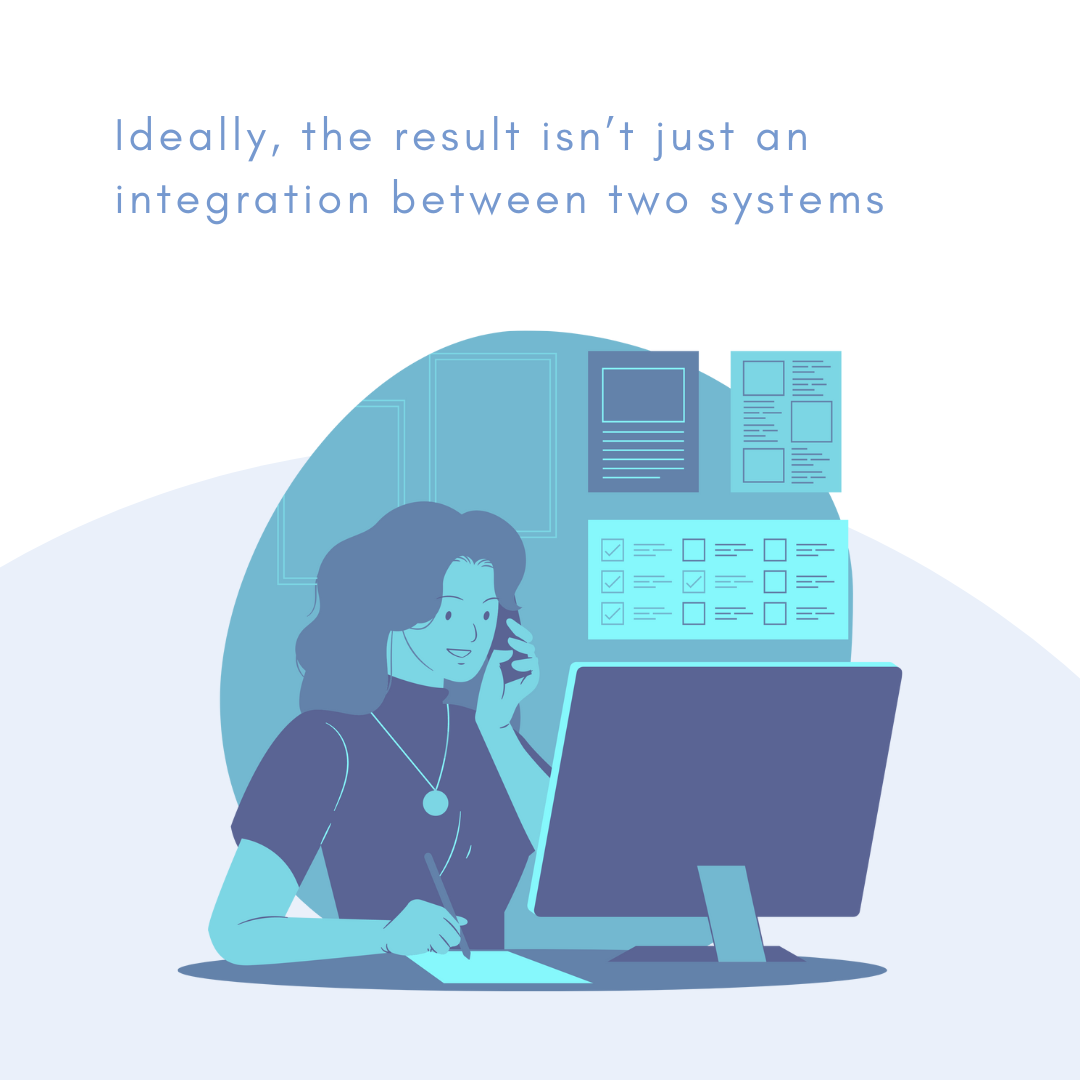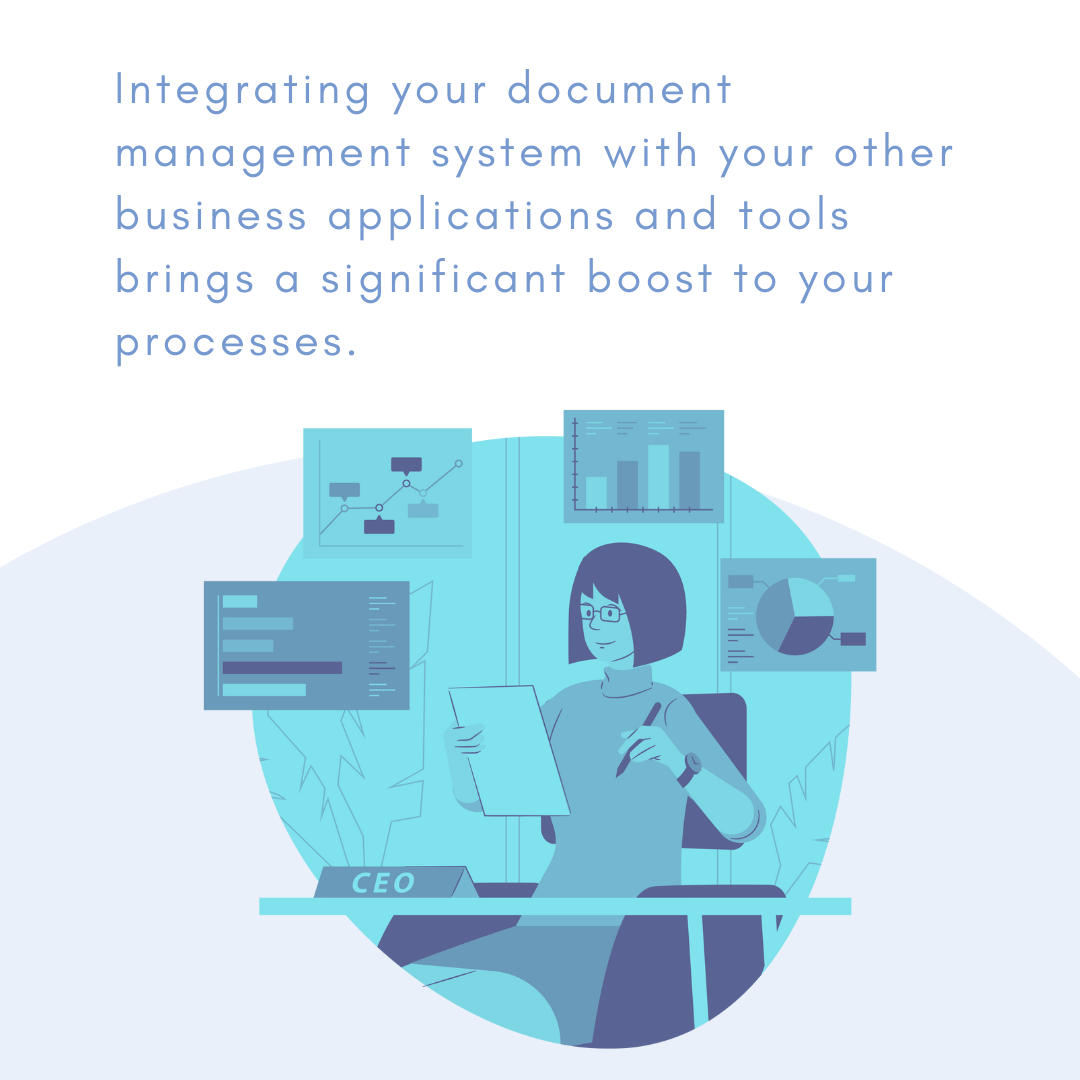NOTE: I decided to ask
ChatGPT
to help me out with some definitions, officially because it's emerging tech, but we all know that it's nice to have a co-author.
A document management system is a major step forward for organizations that are looking to grow effectively and/or reduce costs and inefficiencies. But moving away from paper documents or a simple file storage product is only the first step; integrating your document management system with your other business applications and tools brings a significant boost to your processes.
Here are a few of the more common examples of how integrations can boost the value of your document management system:
-
Your Customer Relationship Management (CRM) system
What is a CRM?
From
ChatGPT:
Customer relationship management (CRM) software is a type of software that helps organizations manage their interactions and relationships with customers, clients, and sales prospects. It can be used to track and manage customer data, sales leads, and marketing campaigns, as well as to analyze customer behavior and provide insights for improving customer relationships.
Most professional-level CRMs provide reliable contact workflows for account and even prospect management, and often have good integration with email systems.
One area that isn’t as well-integrated with CRMs is document handling; while CRMs like
HubSpot
may provide a file storage area that can support uploads, providing attachments such as marketing materials and training documents without more robust document control can result in the wrong version of the material being shared. Integrating your document management system with its more robust document control will help to ensure that the right documents are being shared with the right customers and prospects.
-
Your Website Content Management System (WCM, aka CMS)
What is a WCM?
From
ChatGPT:
A content management system (CMS) is a software application or set of related programs that are used to create and manage digital content. CMSs are typically used for enterprise content management (ECM) and web content management (WCM). WCM systems are used to manage and publish web content, typically for the purpose of creating and maintaining websites. WCM systems provide tools for creating, editing, and organizing web content, as well as managing the workflow of content creation and publication.
Similarly to your customer relationship management, your website’s content management system will have some file storage functionality, but versioning of documents, such as PDFs, as well as the classification of digital assets such as images and video files, could rely on your document management system for handling the original source content, and could also provide resized and optimized versions for your website or other applications.
-
Your Document Creation and Collaboration software
What is document collaboration software?
From
ChatGPT:
Document collaboration software is a type of software that allows multiple users to work on the same document at the same time, regardless of their location. It enables real-time collaboration and communication between team members, making it easier to share ideas and work together on projects.
Tools such as Google Drive and Office 365 can be integrated with your document management system, allowing you to add better document classification, discovery, and document control. If your document management system supports inline collaboration, you could make document changes within your DMS, possibly removing manual processes like downloading and re-uploading documents after editing.
-
Your Project Management software
What is project management software?
From
ChatGPT:
Project management software is a type of software that helps organizations plan, execute, and track projects. It is designed to support the full project management life cycle, from initial planning and scheduling to execution and delivery.
Most applications that allow for project management do not offer robust document management; integration can allow linkage between a project or task and project documents stored in your DMS.
A key component of project management is providing deliverables, such as reports or other documents. This is not always a feature provided within the project management system itself, so an integrated DMS can provide better management of these deliverables.
-
Your Human Resources Information System
What is project management software?
From
ChatGPT:
A human resources information system (HRIS) is a software application or set of related programs that are used to manage and organize HR data and processes. HRIS systems are typically used by organizations to automate and streamline HR-related tasks, such as payroll, benefits administration, performance management, and talent management.
Employee documents and complex workflows such as onboarding and offboarding can be improved upon by using a robust and customizable document management system as a document store and process automation tool.
A growing component of people management is compliance management, such as ensuring that all team members have read and accepted specific policies around security and acceptable use or behavior. When that is unavailable or unsuitable within an HRIS, a good document management system with process and approval workflows can provide this functionality.
-
Your Learning Management System
What is a learning management system?
From
ChatGPT:
A learning management system (LMS) is a software application or set of related programs that are used to plan, deliver, and track training and educational programs. LMSs are typically used by organizations to manage and deliver online learning programs, such as e-learning courses and virtual classrooms.
Most organizations need a repository for Standard Operating Procedures (SOPs) and other Documentation, as they are a major component of scaling an organization as it grows. This can be combined with learning modules to provide a more robust training experience for team members. A document management system can serve as a documentation repository, or in the case of organizations that already have software for documentation, a DMS can integrate that documentation with an LMS or other training systems.
-
Your Financial Planning and Accounting Systems
What are financial planning and accounting systems?
From
ChatGPT:
Financial planning and accounting systems are software applications or sets of related programs that are used to manage and analyze financial data and processes. These systems are typically used by organizations to automate and streamline financial tasks, such as budgeting, forecasting, and reporting.
As with other systems that have rudimentary file handling functionality, integrating your more robust and centralized document management system can ensure that documents are handled consistently.
One common scenario is where an array of financial documents exist with different levels of sensitivity, but all documents exist only within financial software that is not generally provided to more than the finance team. Having the ability to share documents to other teams, when acceptable, while maintaining control over those documents is something that may require a document management solution.
-
Your Report and Analytics software:
What is report and analytics software?
From
ChatGPT:
Report and analytics software is a type of software that is used to generate reports and analyze data. It is designed to help organizations extract insights and make data-driven decisions by presenting data in an organized and easy-to-understand format.
Rather than relying on the different reporting provided by various applications and tools, combining data from various sources through importing into a report and analytics tool can create more robust metrics and visualizations. A flexible document management system can provide its own analytics to such a system, or can even assist in the integrations.

Ideally, the result isn’t just an integration between two systems. While integration between a given application and your document management system provides clear value, using your document management system as a coordinating, centralized system can provide a consistent mechanism for enforcing organizational standards around versioning, security and compliance, and classification. The end goal is a robust document management system that is designed to be integrated across departments and functions, while maintaining document control.
For every system listed, there are multiple other applications that could be used by an organization, such as enterprise resource planning, fleet management, inventory control, supply chain management, and information technology service management.
When the right document management system is employed, it can become the center of your organization. In essence, that is what separates document management from its more powerful version, enterprise content management. It’s all about the integrations.
 FormKiQ vs. Off-the-Shelf Software and Less Flexible SaaS When is FormKiQ a better choice than Off-the-Shelf Software and Less Flexible SaaS?
FormKiQ vs. Off-the-Shelf Software and Less Flexible SaaS When is FormKiQ a better choice than Off-the-Shelf Software and Less Flexible SaaS? FormKiQ vs. Building It Yourself How does FormKiQ save time over custom in-house solutions?
FormKiQ vs. Building It Yourself How does FormKiQ save time over custom in-house solutions? Use Cases FormKiQ works for small and large workflows, across all verticals and industries.
Use Cases FormKiQ works for small and large workflows, across all verticals and industries. FormKiQ For Teams Find out how FormKiQ can work for your team
FormKiQ For Teams Find out how FormKiQ can work for your team FormKiQ For Industries Discover the advantages FormKiQ can bring to your industry
FormKiQ For Industries Discover the advantages FormKiQ can bring to your industry Blockchain and Decentralized Storage Leverage web3 technologies including proof of work and distributed systems for document control and data privacy
Blockchain and Decentralized Storage Leverage web3 technologies including proof of work and distributed systems for document control and data privacy Content and Digital Asset Management Integrate with your preferred web content management system while leveraging FormKiQ for managing your digital assets
Content and Digital Asset Management Integrate with your preferred web content management system while leveraging FormKiQ for managing your digital assets Document Management Module Integrate all of the required functionality of a document management system into an existing software solution
Document Management Module Integrate all of the required functionality of a document management system into an existing software solution Integration with QMS or LIMS Add missing functionality for your Quality Management or Laboratory Information Management by integrating with FormKiQ
Integration with QMS or LIMS Add missing functionality for your Quality Management or Laboratory Information Management by integrating with FormKiQ Job Application Form Receive applications, including cover letter and resume attachments, and import into an existing HR Management System
Job Application Form Receive applications, including cover letter and resume attachments, and import into an existing HR Management System Legal Discovery Tool Find information quickly by combining full-text search with AI-powered document classification
Legal Discovery Tool Find information quickly by combining full-text search with AI-powered document classification The Paperless Office: Digital Document Processing Collect, process, and store paper and digital documents, allowing for archival, integration, and future recall
The Paperless Office: Digital Document Processing Collect, process, and store paper and digital documents, allowing for archival, integration, and future recall Product Leasing System Process client lease applications, including a credit check and approval workflow
Product Leasing System Process client lease applications, including a credit check and approval workflow Company-Wide Break down the silos in your organization with a centralized control center for documents, ready for integration with any and all systems
Company-Wide Break down the silos in your organization with a centralized control center for documents, ready for integration with any and all systems Engineering and Product Reduce development time and agony with battle-tested components for your applications
Engineering and Product Reduce development time and agony with battle-tested components for your applications Finance and Accounting Process paper and electronic invoices and receipts, ready for integration with your important systems
Finance and Accounting Process paper and electronic invoices and receipts, ready for integration with your important systems HR and Recruiting Build and support your people across the organization by integrating with your essential tools
HR and Recruiting Build and support your people across the organization by integrating with your essential tools IT and InfoSec Provision a secure document store with the encryption and controls needed for compliance and protection
IT and InfoSec Provision a secure document store with the encryption and controls needed for compliance and protection Legal Manage and safeguard contracts and other essential documents across systems
Legal Manage and safeguard contracts and other essential documents across systems Marketing Add better discovery and reliability to digital assets and other essential content, while enabling integration with a web content management system
Marketing Add better discovery and reliability to digital assets and other essential content, while enabling integration with a web content management system Sales Keep track of sales assets and contracts inside and outside of your CRM and other tools
Sales Keep track of sales assets and contracts inside and outside of your CRM and other tools Accounting, Financial Services, and FinTech Standardize financial documents, metadata, and workflows across systems, teams, auditors, and clients
Accounting, Financial Services, and FinTech Standardize financial documents, metadata, and workflows across systems, teams, auditors, and clients Education, Training, and EdTech Integrate Learning Management Systems with other essential applications and tools
Education, Training, and EdTech Integrate Learning Management Systems with other essential applications and tools Healthcare, Life Sciences, and MedTech Combine secure and compliant records management with laboratory information management systems
Healthcare, Life Sciences, and MedTech Combine secure and compliant records management with laboratory information management systems Law Practices and Legal Services Ensure efficient legal discovery and case management
Law Practices and Legal Services Ensure efficient legal discovery and case management Logistics and Transportation Provide a robust and customized solution for fleet management or other logistics needs
Logistics and Transportation Provide a robust and customized solution for fleet management or other logistics needs Manufacturing, Production, and Utilities Control and distribute essential documents and standard operating procedures within and between facilities, partners, and clients
Manufacturing, Production, and Utilities Control and distribute essential documents and standard operating procedures within and between facilities, partners, and clients Online Entertainment, Gaming, and Gambling Provide the required compliance documents to partners, customers, and government agencies
Online Entertainment, Gaming, and Gambling Provide the required compliance documents to partners, customers, and government agencies Professional and Technical Services Ensure that clients, inspectors, and subcontractors are aligned with consistent document control
Professional and Technical Services Ensure that clients, inspectors, and subcontractors are aligned with consistent document control Tech Startups Build robust document management functionality into your disruptive product
Tech Startups Build robust document management functionality into your disruptive product







